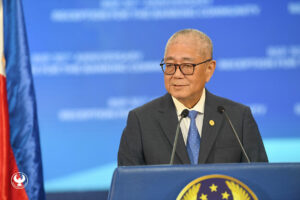BSP to cut RRR ‘substantially’ this year
THE BANGKO SENTRAL ng Pilipinas (BSP) plans to reduce the reserve requirement ratio (RRR) “substantially” this year, its top official said.

By Luisa Maria Jacinta C. Jocson, Reporter
THE BANGKO SENTRAL ng Pilipinas (BSP) plans to reduce the reserve requirement ratio (RRR) “substantially” this year, its top official said.
“We’re considering it. We’ve discussed the timing of it. I would say it’s going to happen this year,” BSP Governor Eli M. Remolona, Jr. said in a press chat on Wednesday.
“We will reduce reserve requirements substantially this year and then there may be further reductions by next year,” he added.
The RRR is the portion of reserves that banks must hold onto rather than lending out.
The BSP reduced the ratio for big banks and nonbank financial institutions with quasi-banking functions by 250 bps to 9.5% in June 2023.
It also lowered the ratio for digital banks by 200 bps to 6% and by 100 bps for thrift banks, and rural and cooperative banks to 2% and 1%, respectively.
The central bank has since brought down the RRR for universal and commercial banks to a single-digit level from a high of 20% in 2018.
“The banks want a reduction of the reserve requirement and they’re saying ‘if you do reduce it, we’ll do this other thing for you,’ reduce transaction costs on payments, for example,” Mr. Remolona said.
“We’re trying to manage that. But the idea is to reduce the reserve requirements in a substantial way,” he added.
The BSP governor earlier said that they are eyeing to bring down the RRR to as low as 5%.
Meanwhile, Mr. Remolona said that the RRR cuts’ impact on the economy will not be immediate.
“Our transmission mechanism has long lags. That’s partly because the markets are not deep and liquid. We take account of those lags,” he said.
“At the same time, we’re trying to improve the liquidity of the markets to shorten those lags. But that’s an effort that will take some time.”
BSP Assistant Governor Zeno R. Abenoja said that slashing the RRR could spur lending activities and economic growth.
“We are hoping additional liquidity will be deployed to help expand productive economic activities. However, that will take time,” he said.
“So, some of it will be deployed by banks in various financial markets, including government securities, equity, but some of it may still reside in their accounts, including depositing it back to the BSP.”
The RRR cuts in June last year coincided with the expiration of the BSP’s pandemic relief measures, which allowed banks to count their lending to small businesses as part of their compliance with the reserve requirement for deposit liabilities and substitutes.
“In terms of liquidity, the reserves for the reserve requirement are on our balance sheet on the same side, on the liabilities side. So, if we cut the reserve requirement, that part will go down and we want to compensate for that,” Mr. Remolona said.
“So, that’s more liquidity for the bank system and we want to compensate for that by absorbing back some of that liquidity, which will go into some other part of our balance sheet,” he added.
The BSP chief earlier said that the Philippines’ current RRR is among the highest in Asia. He also said reserve requirements “drive a wedge” between deposit rates and lending rates.
When a bank is required to hold a lower reserve ratio, it has more funds to lend to borrowers. This increases the bank’s lending capacity, impacting its ability to support economic growth and meet the credit needs of individuals and businesses.
















